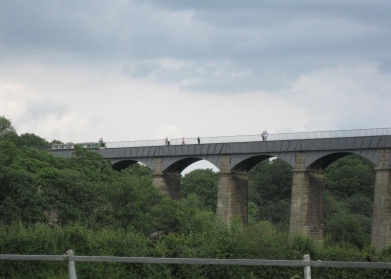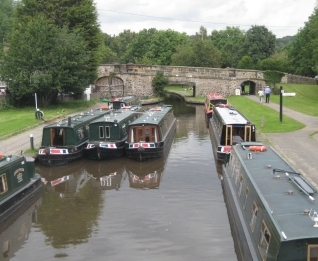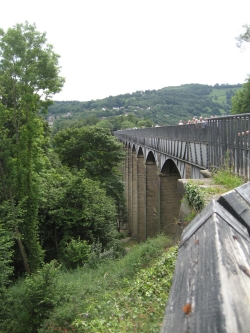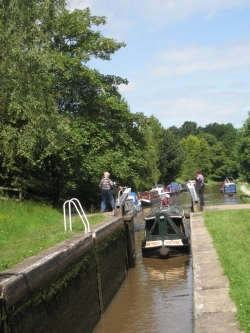
Click for
Map of North Shropshire
Canals |
Development in North Shropshire
Despite its low-lying position, Wem was never considered as a routeway for a canal and thus suffered for a long time with inadequate transport. The nearest completed main-line canal was the Ellesmere canal from Hurlston Jct on the Birmingham & Liverpool canal which went south-westwards via Whitchurch to Frankton, where it divided. The southern branch passed through Llanymynech to Welshpool. A northern branch went to Ruabon where it met the Llangollen canal, which was a major provider of water. That branch crosses the spectacular Pontcysyllte viaduct (below) which was opened in 1795.
|
The Prees Branch
A short branch was proposed to Prees Higher Heath to bring coal from Ruabon and limestone from Weston for distribution to the farmers.
The branch was never actually completed. It was built to Quina Brook with the major wharf at Edstaston. It was to there that horse drawn carts pulled the loads to and from Wem along the turnpike road.Pigot's 1835 directory listed under the heading of 'Conveyance by Water" "To CHESTER, NANTWICH, WHITCHURCH, SHREWSBURY, ELLESMERE and all intermediate places. Fairhurst, Tilston and Co. and Turton & Co. from Edstaston Wharf" |
 |

Click for map
of canals near Wem | Edstaston
In 1851, Edstaston had a population of 397. These included:
George & Abraham Ruscoe- coal, slate, tile, general tillage and lime merchants
John Brown – Coal merchant
John Hayward- coal agent
Richard Thomas – Innkeeper ‘The Duke of Wellington’ and agent & canal clerk for the canal company (known as a ‘wharfinger’).
Presumably, others were labourers, but these are not listed.
|
The decline of freight on the Prees Canal
By 1870, the picture had changed. Cassey lists no canal-related occupations as the new Crewe-Shrewsbury and Whitchurch- Oswestry railways had effectively killed the canal trade. The slow movement of freight, especially on the multi-lock sections of many canals was a major disadvantage. Locks too were slow to operate and required large quantities of water, leading to them being narrowed to economise on water. This in turn restricted the width of the boats and led to many canals in the country being constructed on a narrow gauge (less than 2.1 metres wide) Edstaston’s only non-farm-related occupations in 1870 were inn-keepers (The Canal Tavern and the Harp Inn), 3 shopkeepers and a carpenter. |
 |  | 
|
| Boats on the Llangollen canal- the narrowness of the canal was a major restriction on trade | Pontcysyllte Aquaduct.Both canals and railways produced spectacular feats of Victorian engineering | Lock at Audlem on the Shropshire Union Canal-a restriction on speed on movement |
Closure and revival
The Ellesmere canal was closed to navigation by Act of Parliament in 1944, but was retained as a water feeder for the Shropshire Union canal and as a route for drinking water supply. However, it became popular with pleasure boats and a marina opened at Dobson’s Bridge on the Prees canal. The rest of that canal is derelict beyond the marina. |





